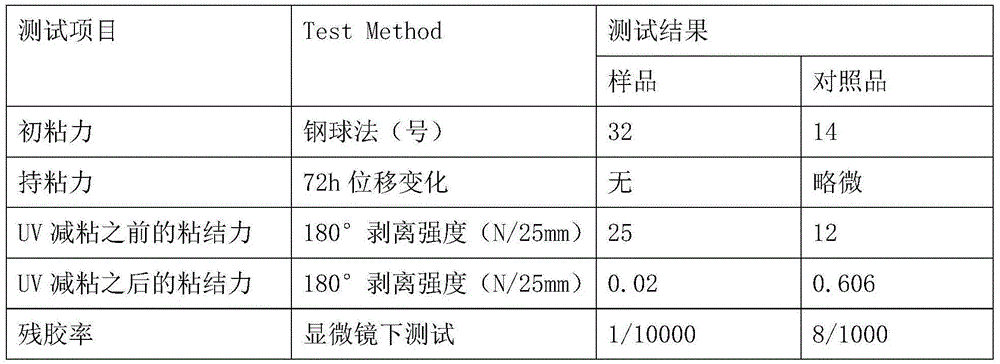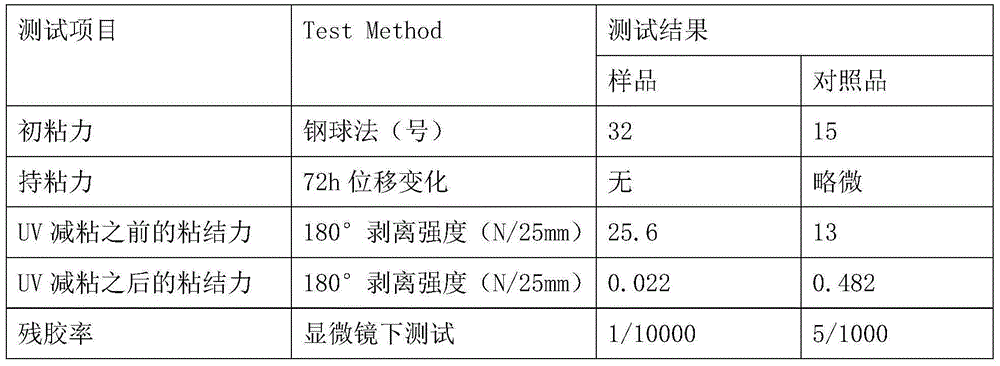Bi-component cured UV viscosity-decreasing adhesive
A two-component, adhesive technology, applied in the direction of coating, polyurea/polyurethane coating, etc., can solve the problems of reducing peeling force, insufficient bonding strength, and troublesome synthesis process, so as to avoid processing displacement, Improvement of peeling effect and improvement of initial tack
- Summary
- Abstract
- Description
- Claims
- Application Information
AI Technical Summary
Problems solved by technology
Method used
Image
Examples
Embodiment 1
[0036] 1. Formula
[0037] (1) Component A
[0038] Curing resin: AC3470 (obtained by the homopolymerization of hydroxyl-containing (meth)acrylic monomers, 3.6% of hydroxyl content and molecular weight of 4500) produced by 60g of Canada's Noda Chemical Company;
[0039] Photosensitive monomer: 22g hydroxypropyl methacrylate (active photosensitive monomer containing hydroxyl, molecular weight 144);
[0040] Photopolymerization initiator: 3g1-hydroxycyclohexyl phenyl ketone, 2g2,4,6-(trimethylbenzoyl) diphenylphosphine oxide;
[0042] Additives: 1g defoamer BYK067, 1g leveling agent BKY333, 1g antistatic agent HDC320.
[0043] (2) Component B
[0044] 10 g of HDI-type aliphatic polyisocyanate N3390 (hexamethylene diisocyanate trimer, NCO content 19.6±0.3%, molecular weight 215) produced by Bayer Company of Germany.
[0045] 2. Preparation method
[0046] (1) Add the cured resin, photosensitive monomer, photopolymerization initiator, diluent an...
Embodiment 2
[0072] 1. Formula
[0073] (1) Component A
[0074] Curing resin: 38g of SM2810 (hydroxyl functional acrylic resin crosslinked with polyurethane, hydroxyl content 4.1%, molecular weight 8000) produced by 38g U.S. Cytec (CYTEC) company;
[0075] Photosensitive monomer: 45g methacryloyloxyethyl succinic acid monoester (carboxyl-containing active photosensitive monomer, molecular weight 230);
[0076] Photopolymerization initiator: 4 g of 2-methyl-2-(4-morpholinyl)-1-[4-(methylthio)phenyl]-1-propanone
[0078] Additives: 1g defoamer Dow Corning DC62, 2g leveling agent Glide425, 3g Clariant SAS93.
[0079] (2) Component B
[0080] The aromatic polyisocyanate L75 (aromatic polyisocyanate of TDI type, NCO content 13.3 ± 0.4%, molecular weight 315) of TDI type produced by 20g Bayer Company
[0081] 2. Preparation method
[0082] (1) Take the cured resin, photosensitive monomer, photopolymerization initiator, diluent and auxiliary agent and add the...
Embodiment 3
[0108] 1. Formula
[0109] (1) Component A
[0110] Cured resin: NeoRadU-30W (obtained by the addition of aromatic polyurethane and polyalcohol, acid value 8mgKOH / g, carboxyl content is 6%, molecular weight 4400) produced by 35g Holland DSM (DSM);
[0111] Photosensitive monomer: 45g hydroxyethyl methacrylate (active photosensitive monomer containing hydroxyl, molecular weight 130);
[0112] Photopolymerization initiator: 8g 2-hydroxy-2-methyl-1-phenyl-1-propanone, 2g 2,4,6-(trimethylbenzoyl) diphenylphosphine oxide;
[0113] Diluent: 2g butyl acetate;
[0114] Additives: 2g defoamer Dow Corning DC62, 3g leveling agent BKY333, 3g antistatic agent HDC320.
[0115] (2) Component B
[0116] 5 g of HI-190 (hexamethylene diisocyanate trimer, NCO content 19.8±0.5%, molecular weight 504) produced by BASF, Germany.
[0117] 2. Preparation method
[0118] (1) Take the cured resin, photosensitive monomer, photopolymerization initiator, diluent and auxiliary agent and add them to t...
PUM
| Property | Measurement | Unit |
|---|---|---|
| peel strength | aaaaa | aaaaa |
| peel strength | aaaaa | aaaaa |
| acid value | aaaaa | aaaaa |
Abstract
Description
Claims
Application Information
 Login to View More
Login to View More - R&D
- Intellectual Property
- Life Sciences
- Materials
- Tech Scout
- Unparalleled Data Quality
- Higher Quality Content
- 60% Fewer Hallucinations
Browse by: Latest US Patents, China's latest patents, Technical Efficacy Thesaurus, Application Domain, Technology Topic, Popular Technical Reports.
© 2025 PatSnap. All rights reserved.Legal|Privacy policy|Modern Slavery Act Transparency Statement|Sitemap|About US| Contact US: help@patsnap.com



